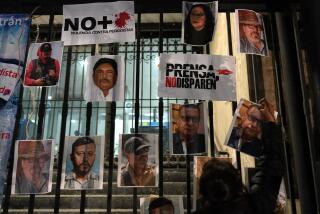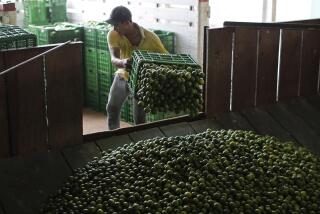Chiapas Refugees Straggle Back . . . Cautiously : Mexico: Villagers who refused to fight with Zapatista rebels fear trouble if the army withdraws.
- Share via
MARAVILLAS, Mexico — After five months in refugee camps, Pedro Santis and his neighbors are back in their hometown, until recently part of rebel-held territory in the southern state of Chiapas. They say they will only stay as long as the Mexican army does.
“We have asked for a permanent barracks,” Santis said. “We know that if the army leaves, the trouble will start again.”
The “trouble,” he said, included vague threats from the Zapatista National Liberation Army, and, finally, in September, an ultimatum to join the guerrilla movement or leave. Santis and 430 of his neighbors left town Oct. 2. They did not come back until the Mexican army moved in last month.
Voices such as Santis’ provide a compelling argument against the Zapatista insistence that peace talks cannot begin until troops pull out of the area that rebels governed for more than a year.
And the government is making a concerted effort to ensure that those voices are heard. After months of being cornered by the skillful public opinion manipulation of the Zapatistas--with their poetic communiques and dramatic videotapes--the government is taking the initiative in the propaganda war.
Four or five times a week for the past month, army helicopters have flown squadrons of journalists out to jungle villages like Maravillas to talk with people like Santis. The tours include briefings with area military commanders, giving reporters a rare chance to interview top-ranking officers of an army known for shunning public exposure.
The organized visits are an impressive effort to get out a message--that the army’s continued presence is essential in the former rebel-held territory--by an administration that has been roundly criticized for failing to communicate.
Since the first 10 days of January, 1994--when fighting left 145 people dead--Chiapas has been a war of pens rather than swords. And the pen that has dominated has been that of the enigmatic Subcommander Marcos, whose sometimes-fanciful communiques were published in full in Mexican newspapers and typed into the Internet computer network to be sent around the world.
Even after the government identified Marcos as Rafael Sebastian Guillen Vicente on Feb. 9 and sent the army into the jungle to find him, the rebel propaganda machine was able to respond. Within days, a Zapatista leader was issuing communiques accusing the army of atrocities in the region. That forced the government, which had banned journalists and human rights activists from the area where troops were on the move, to lift the military blockades.
Now the government is trying to win a propaganda battle. And the issue it is taking on is the final major hurdle to peace talks: the army’s continued presence in an area, about half the size of Delaware, that the rebels once held.
When the army rolled into the jungle Feb. 10, rebel supporters headed for the hills. Most are still there.
In communiques discussing conditions for talks, Zapatistas have said it is logistically impossible for them to negotiate while many of their supporters are hiding from soldiers. They have demanded that troops be withdrawn to positions occupied before Feb. 9.
The National Mediation Commission, a go-between organization recognized by both the government and the Zapatistas, has supported the rebel demand. “The two armies must be separated,” a commission proposal released last month stated.
The government is casting the argument in a different light, through the viewpoint of people like Santis.
Since the uprising began and the rebels took over a swath of territory in southeastern Chiapas, tension had grown between Zapatista supporters and their pacifist neighbors. Increasingly impatient with rebel roadblocks and “taxes,” pacifists provided soldiers with detailed reports about guerrilla activities in their communities.
Those tensions grew after federal and state elections in August that the Zapatistas claim were racked with fraud. In September, non-Zapatistas were told to join the movement or leave, according to both refugees and rebel supporters in various communities.
“The refugees are those who have suffered most,” said Gen. Alfonso Hernandez, commander of the troops assigned to assist civilians in Chiapas. In all, he estimated that 28,000 people fled rebel-held territory. “We anticipate that nearly everyone will have returned within two weeks,” Hernandez said.
Not all of those returns have been amicable. Refugees were gone during the months of the coffee harvest. They returned to find that their only cash crop had been picked and that the rebels had kept the proceeds.
In towns such as Maravillas, where some Zapatistas have surrendered, tensions remain between the two groups. Military commanders contend that rather than separating the Mexican army from the Zapatistas, what is needed is to separate the rebels from their neighbors.
“We are like a peacekeeping force,” said Gen. Mario Hernan Castillo, commander of the 7th Division, which includes Chiapas.
To fulfill that role, while trying to address the Zapatistas’ objection to their continued presence, the troops have moved their camps to a mile or more outside most villages.
But that has not been enough to persuade most rebel supporters to return. Guadalupe Tepeyac, a town at the entrance of what was once rebel-held territory and the site of many Zapatista ceremonies, remains deserted.
Gen. Guillermo Martinez Nolasco, the zone commander, said about 25 people from nearby villages have surrendered to him, turning in their weapons: a .22-caliber rifle, two shotguns and two sticks with machetes strapped to them.
But while a few former rebels have surrendered, others have driven deeper into the jungle--and tensions across the increasingly polarized state have grown.
Clashes last week between political parties over land issues--a constant problem in this state--left five people dead and 18 injured near Yajalon, west of the former rebel-held zone, according to press reports. One of the victims had been scalped and tortured, according to the reports.
More to Read
Sign up for Essential California
The most important California stories and recommendations in your inbox every morning.
You may occasionally receive promotional content from the Los Angeles Times.










